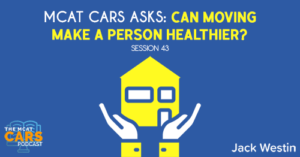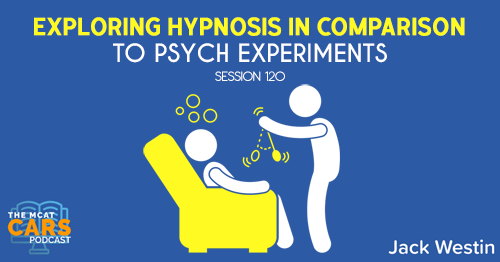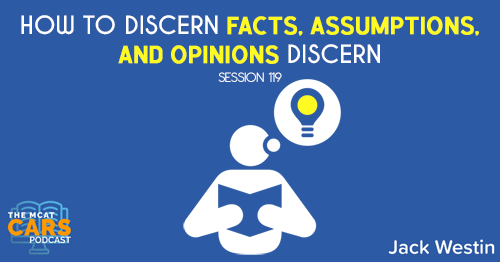Apple Podcasts | Google Podcasts

Session 43
This passage looks at the connection between housing, proximity to poverty, and health. If you’re looking for some more MCAT CARS help, check out Jack Westin’s course to learn a stepwise approach to CARS passages! Sign up for his free daily CARS passages delivered right into your inbox every day.
Listen to this podcast episode with the player above, or keep reading for the highlights and takeaway points.
[02:00] What to Expect from Jack Westin’s Course
When you read something, your mind will go everywhere. You might go to one paragraph or the next. Or you might start assuming things you didn’t read. This is common, especially when you’re not aware of what exactly is being said.
In Jack Westin’s course, he breaks down things using steps. So when you read, it’s kind of different than what’s done here. In the course, you’re shown how to do this efficiently and how to find the big ideas quickly.
You don’t have time to summarize every sentence throughout every passage on the test. In the course, you’re shown how to take the steps, what strategies to use them, when to use them, how to summarize, and what skills to use. The steps they teach almost always lead you to the right answer.
Then you can go back and see where in the steps you made a mistake. You can hone on your weakness and get better at it so you will eventually make no mistakes.
'When passages start to be difficult is if you start making assumptions.'Click To TweetAnother mistake students make is when they start to make assumptions. Don’t challenge what the author is saying. Embrace it and accept it. At the end of the day, you have to stick to their opinion.
Focus on the trends. Focus on the patterns and you will do well.
Link to article:
https://getpocket.com/explore/item/why-living-in-a-poor-neighborhood-can-change-your-biology
It was the most ambitious social experiment ever conducted by the United States Department of Housing and Urban Development. And one of the most surprising.
In 1994, HUD randomly assigned 4,600 poor, mostly African-American families in Baltimore, Boston, Chicago, Los Angeles, and New York to one of three groups. One group received housing vouchers intended to help them move to low-poverty neighborhoods. Another group received vouchers without geographic restrictions. A final control group didn’t receive vouchers at all.
Called “Moving to Opportunity,” the study was designed to answer a question that had divided social scientists and policymakers for decades: Did getting people off of welfare and other forms of social assistance depend on changing their social context?
More than a decade later, the researchers found that a lot of things hadn’t changed. Many people offered housing vouchers didn’t move. The people who did move to better neighborhoods didn’t change their diets or daily lifestyles. Their kids showed no improvement in reading or math scores. And moving didn’t make people any more or less economically self-sufficient, the question the study was designed to answer.
But as the experiment went on, researchers began encountering anecdotal evidence that surprised them. The people who moved out of poor neighborhoods were healthier. When they went back and measured the differences between people who got vouchers and people who didn’t, the results were remarkable: The people who got vouchers to move to low-poverty neighborhoods had significantly lower rates of obesity and Type 2 diabetes.
Robert Whitaker, a pediatrician and public-health expert at Temple University, co-authored a report on the HUD study for the New England Journal of Medicine in 2011. “By dint of the design, the cause of the difference in diabetes and obesity was the voucher and the move to a less-distressed neighborhood,” Whitaker says. “The amazing thing is that the cause of the difference in obesity and diabetes was the move.”
[06:13] Paragraph 1, Sentences 1-2
It was the most ambitious social experiment ever conducted by the United States Department of Housing and Urban Development. And one of the most surprising.
Jack says:
The author talks about housing for the population in general.
[06:55] Paragraph 2, Sentence 1
In 1994, HUD randomly assigned 4,600 poor, mostly African-American families in Baltimore, Boston, Chicago, Los Angeles, and New York to one of three groups.
Jack says:
We’re given a backstory here. And know these families are poor.
[07:30] Paragraph 2, Sentence 2
One group received housing vouchers intended to help them move to low-poverty neighborhoods.
Jack says:
So this is one of the three groups.
[07:42] Paragraph 2, Sentences 3-4
Another group received vouchers without geographic restrictions. A final control group didn’t receive vouchers at all.
Jack says:
Then the second and third groups are mentioned here. So there are three different groups here. One is to help them move to low poverty neighborhoods. Another group allowed them to move wherever they wanted. And the last group didn’t get any vouchers. Voucher is some kind of money or funds.
[08:45 Paragraph 3, Sentence 1
Called “Moving to Opportunity,” the study was designed to answer a question that had divided social scientists and policymakers for decades: Did getting people off of welfare and other forms of social assistance depend on changing their social context?
Jack says:
Do we change their location? Who are they around? As you can see in this experiment, two of the groups moved people while the control group didn’t move. They stayed in poor neighborhoods. One of them moved to a lower poverty kind of neighborhood. The other one had the option of moving wherever they wanted to.
[10:05] Paragraph 4, Sentence 1
More than a decade later, the researchers found that a lot of things hadn’t changed.
Jack says:
The author is setting up some of the results here. Now it’s saying it doesn’t help them.
[10:27] Paragraph 4, Sentences 2-3
Many people offered housing vouchers didn’t move. The people who did move to better neighborhoods didn’t change their diets or daily lifestyles.
Jack says:
There are people who didn’t move. While there those people who moved didn’t change their lifestyle.
[10:52] Paragraph 4, Sentence 4
Their kids showed no improvement in reading or math scores.
Jack says:
We’re given additional data including data, lifestyle, and education.
[11:10] Paragraph 4, Sentence 5
And moving didn’t make people any more or less economically self-sufficient, the question the study was designed to answer.
Jack says:
The moving of people didn’t really help people at all. You were hopefully expecting some results but nothing’s changing. Things are the same even if you do move. Most of them didn’t move though. But even if they didn’t, it change anything so far.
[11:57] Paragraph 5, Sentence 1
But as the experiment went on, researchers began encountering anecdotal evidence that surprised them.
Jack says:
Something happened that researchers weren’t expecting.
[12:12] Paragraph 5, Sentence 2
The people who moved out of poor neighborhoods were healthier.
Jack says:
This is confusing because it said that once they moved, they didn’t change their diet or daily lifestyle. Students can give up at this point. But it’s okay. Maybe diet and lifestyle can contribute to their health but there are many other factors that can also contribute to health. Maybe it can be your stress level or sleep quality. There could be other ways of looking at health aside from lifestyle and diet.
[13:22] Paragraph 5, Sentence 3
When they went back and measured the differences between people who got vouchers and people who didn’t, the results were remarkable: The people who got vouchers to move to low-poverty neighborhoods had significantly lower rates of obesity and Type 2 diabetes.
Jack says:
This is how they got healthier with lower rates of obesity and Type 2 diabetes. This is the fight here: so if they move, they didn’t change their diet and lifestyle. But how could they be healthier? Just go with it and accept it.
[14:12] Paragraph 5, Sentence 1
Robert Whitaker, a pediatrician and public-health expert at Temple University, co-authored a report on the HUD study for the New England Journal of Medicine in 2011.
Jack says:
A name is mentioned here where he did a report on the study.
[14:30] Paragraph 5, Sentence 2
“By dint of the design, the cause of the difference in diabetes and obesity was the voucher and the move to a less-distressed neighborhood,” Whitaker says.
Jack says:
We may not know the meaning of “dint” but let’s just ignore that and read the rest. What we know here is that Whitaker is saying that diabetes and obesity are because of the move.
[15:05] Paragraph 5, Sentence 3
“The amazing thing is that the cause of the difference in obesity and diabetes was the move.”
Jack says:
The move changed the rate of obesity and diabetes. There’s got to be some difference there. At least, Whitaker is saying that they moved to a less distressed neighborhood. This move led them to a better place. The fact that they moved helped their health. That’s all that you need to know.
[18:28] Sample Question and Thought Process
The author suggests that a person’s health:
(A) can be improved of the access to better medical care.
(B) could be affected by where that person lives.
(C) improves when that person tries to improve it.
(D) is not affected by the person’s race.
You can immediately crash out A and C since there wasn’t any mention of those. For, D, they did mention African-American and some students may assume this is a discussion of race but this wasn’t really pointed out either. This is just a distraction or a trap. So the correct answer here is B.
Think about what this passage is all about. It’s all about how health is affected by your location and where you moved to.
The thing that makes this question hard is you have to finish the statement. It talks about a person’s health and this could be affected by different factors.
Links:
Link to article:
https://getpocket.com/explore/item/why-living-in-a-poor-neighborhood-can-change-your-biology
SEARCH SITE
SEARCH SITE
LISTEN FOR FREE











